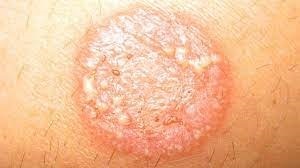Read on to discover 11 natural treatments for fungal infections, such as ringworm:
- Garlic
Garlic paste may be used as a topical treatment, although no studies have been conducted on its use.
Garlic is often used to treat infection. Although there are no studies that examine the effects of garlic on ringworm, it has proven effective Trusted Source for other types of fungi, including Candida, Torulopsis, Trichophyton, and Cryptococcus.
To use garlic as a treatment, make a paste of crushed garlic cloves by blending the garlic with some olive or coconut oil. Apply a thin layer of paste to the affected skin and cover with gauze. Leave in place for up to 2 hours before rinsing. Repeat twice daily until symptoms resolve.
If the garlic paste causes stinging, swelling, or redness, rinse off immediately and do not reapply.
- Soapy water
To prevent ringworm from spreading or infecting other areas of the body, keep the skin as clean as possible. To do this, rinse the infection with soap and warm water once or twice daily. Be sure to dry the skin fully, as fungus thrives in moist areas.
Always clean the skin in this way before using any of the other home remedies listed below. Before using any of the following substances on the ringworm patches, a person should apply a small amount to a healthy area of skin to ensure they do not have a sensitivity or allergy to the treatment.
- Apple cider vinegar
Apple cider vinegar has demonstrated Trusted Source antifungal properties against Candida, another fungal infection.
To treat ringworm with apple cider vinegar, soak a cotton wool pad in the undiluted vinegar and wipe it on the affected area. Repeat up to 3 times daily.
- Aloe vera
Aloe vera contains six antiseptic agents that, according to research Trusted Source, exhibit antifungal, antibacterial, and antiviral activities.
Apply the gel from an aloe vera plant onto the ringworm patch three or four times daily. The gel also has cooling properties, so it may soothe itchy and swollen skin.
- Coconut oil
Certain fatty acids found in coconut oil may kill fungal cells by damaging their cell membranes.
Some research suggests that coconut oil may be an effective remedy for people with mild to moderate skin infections. Use it to treat ringworm by applying liquid coconut oil to the skin three times per day.
Also, people can use coconut oil as a moisturizing lotion, which may be an effective way to prevent future ringworm infections.
- Grapefruit seed extract
Anecdotal evidence suggests that grapefruit seed extract may treat fungal infections. To treat ringworm, proponents recommend mixing 1 drop of grapefruit seed extract with a tablespoon of water and applying to the skin twice daily.
- Turmeric
Turmeric is a popular spice with anti-inflammatory properties. A part of turmeric known as curcumin is believed to be responsible for the spice’s health benefits. Numerous studies Trusted Source detail its extensive antimicrobial abilities.
Consume turmeric as a tea or add it to meals to reap its benefits. For topical applications, mix it with a small amount of water or coconut oil until it forms a paste and apply this to the skin. Leave it to dry before wiping off.
Be aware that turmeric may stain lighter skin a yellow color, but this will fade within a few days.
- Powdered licorice
estLicorice powder can be used to make a paste with antiviral and antimicrobial properties.
A frequently used herb in traditional Chinese medicine, licorice demonstrates antiviral, antimicrobial, and anti-inflammatory properties.
It is also used as a home remedy for ringworm and other fungal infections. For best results, mix 3 tablespoons of powdered licorice root into a cup of water.
Bring this mixture to a boil, then reduce heat and simmer for 10 minutes. Once the liquid has cooled, it should form a paste.
Apply this to the ringworm patch twice a day, allowing it to sit for at least 10 minutes each time before wiping or rinsing off.
- Tea tree oil
Native Australians have used tea tree oil as a remedy Trusted Source for many bacterial and fungal skin conditions for almost a century. Today, tea tree oil is both popular and effective in treating ringworm.
Make a 2 percent dilution of tea tree oil by mixing 12 drops of the essential oil with 1 ounce of cold-pressed carrier oil, such as coconut oil. Apply this to the skin three times daily.
Those who do not have sensitive skin may be able to apply the tea tree oil directly to the affected skin without diluting it first.
- Oil of oregano
Oil of oregano that is made from wild oregano (Origanum vulgare) contains two strong antifungal called thymol and carvacrol.
Some research Trusted Source has shown that oil of oregano can stop the growth of the fungus Candida albicans. Always dilute oil of oregano with carrier oil before use. Apply the oil to the affected area up to three times daily.
Note that the majority of oil of oregano on the market contains common oregano (Origanum marjoram) rather than wild oregano.
- Lemongrass oil
Lemongrass essential oil has been shown to reduce the activity of several types of fungus. To use lemongrass oil for ringworm, mix it with carrier oil, and apply it to the skin twice daily with a cotton ball.
Source: medicalnewstoday.com









